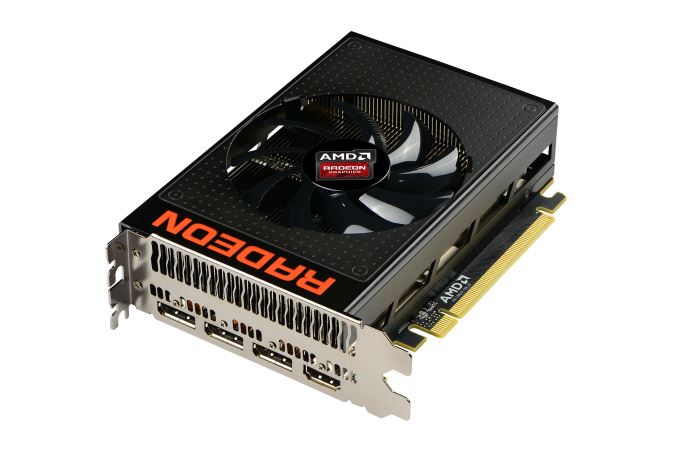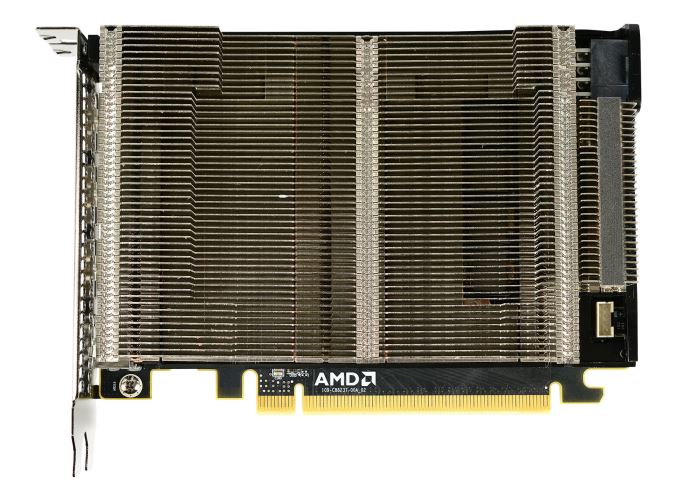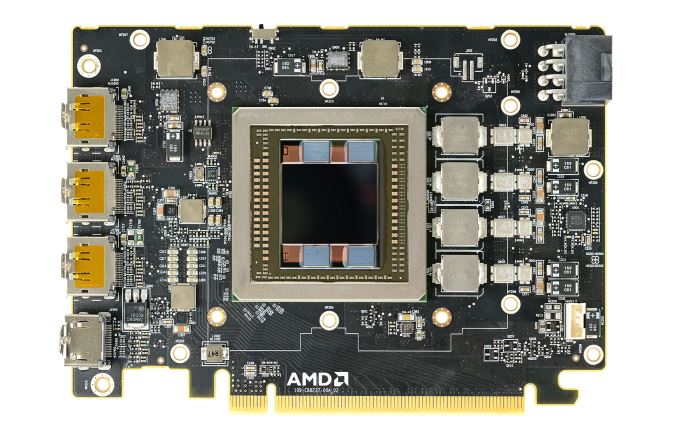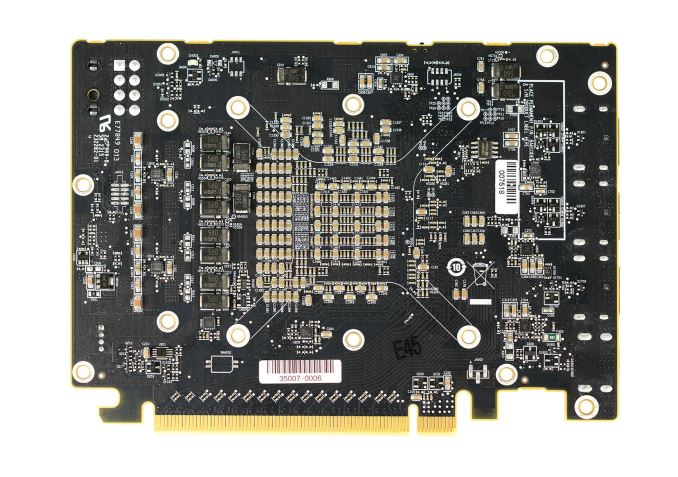The AMD Radeon R9 Nano Review: The Power of Size
by Ryan Smith on September 10, 2015 8:00 AM ESTMeet The Radeon R9 Nano
6 inch video cards are by no means a new thing in the GPU space, however these are traditionally lower-end products that need neither a large cooler nor an extensive power delivery system. As a result the R9 Nano is something of an interesting aberration, packing a lot more power and a lot more technology into half a foot of video card than what we normally see.
Starting as always from the top, the R9 Nano measures 6” long, which is actually a bit shorter than the full length the Mini-ITX standard allows. Responsibility for cooling the card falls to the R9 Nano’s new open air cooler, an aggressive design that has been specifically tailored to allow the card to effectively dissipate 175W of heat in such a small space.
The overall design of the R9 Nano’s cooler is best described as a combination open-air and half-blower hybrid. The design is technically open-air, employing a single axial fan to cool the card. However with only a single fan AMD has been able to align the heatsink fins horizontally and then place the fan in the center of the heatsink. The end result is that roughly half of the heat produced by the card is vented outside of the case, similar to a full blower, while the other half of the heat is vented back into the case. This reduces (though doesn’t eliminate) the amount of hot air being recycled by the card.
The heatsink itself is composed of aluminum and runs virtually the entire length of the card. This is technical a two-piece heatsink, with the primary heatsink composing the bulk of the card, while a much smaller secondary heatsink it found towards the far end of the card and mounted on top of a heatpipe.
Drilling down, we find that the primary heatsink is fed by a combination vapor chamber and heatpipe design. A copper vapor chamber serves to draw heat away from the Fiji GPU and HBM stacks, and then heatpipes are used to better distribute heat to the rest of the heatsink. The use of a vapor chamber in the R9 Nano makes a lot of sense given the fact that vapor chambers are traditionally the most efficient heatsink base type, however the R9 Nano is also unique in that we typically don’t see vapor chambers and heatpipes used together. Other designs such as the high-end GeForce series use a single large vapor chamber across the entire heatsink base, so among reference cards at least the R9 Nano stands alone in this respect. In this case given AMD’s design goals for size and noise, a vapor chamber will play a big part in helping the small card effectively and quietly dissipate 175W.
As for the physical PCB itself, as we can see AMD made it a relatively packed card in order to get the R9 Nano down to 6 inches. Compared to the R9 Fury X reference board, the biggest change here is that AMD has removed a fair bit of power circuitry to save space. By our count there are 4 VRM phases to feed the Fiji GPU, as opposed to the 6 found on R9 Fury X. Power delivery is handled by a single 8-pin PCIe power socket, which is becoming increasingly common, replacing the 2x 6-pin setup for 150W-225W cards.
Meanwhile to further shrink the overall PCB footprint, AMD has moved some of the remaining power delivery circuitry to the back of the card. The front of the card still contains the inductors and heat-sensitive MOSFETs, while a number of capacitors are on the rear of the card (and is why you won’t find a backplate).
Finally, for display I/O R9 Nano is unchanged from R9 Fury X. This means we’re looking at a DVI-free design, with 3x DisplayPort 1.2 and 1x HDMI 1.4 port all along a single row of the I/O bracket. Buyers looking to put together HTPCs will want to be especially mindful of the HDMI 1.4 port; while it's not necessarily a deal-breaker, it does mean that the R9 Nano can't fully drive 4Kp60 TVs, which are slowly but surely becoming more common.
Overall AMD is rather confident in their design for the R9 Nano. The heatsink is built to efficiently dissipate more heat than the 175W the card requires (despite the small size), and as a result we never see the R9 Nano thermally throttle under normal operation. The card’s thermal throttle point is 85C, and in our testing the card never passed 75C, exactly as AMD promised us. What ends up limiting the R9 Nano’s performance then is exactly as expected: the power throttling.
















284 Comments
View All Comments
kallogan - Thursday, September 10, 2015 - link
buy an asus directcu gtx 970 mini-itx, oc it a bit, same perf same power consumption for half the price :)Asomething - Thursday, September 10, 2015 - link
and thats only gonna work at 1080p, even funnier is that you think the 970 dcu mini cooler is adequate for an oc, its running at 74c at its boost speed (not an oc). you wont get much more out of it compared to a full sized 970 (you might get another 100-150mhz at best before you start hitting some limits as kitguru found) which wont get you close enough to the nano's performance above 1080p.Peichen - Thursday, September 10, 2015 - link
Any GTX970 can go up to 1450Mhz boosted if not 1500Mhz from 1178Mhz stock boost. That's more than an 20% overclock and as voltage cannot be changed on Nvidia cards, heat will only go up linearly not exponentially.Gigaplex - Thursday, September 10, 2015 - link
The cooler on the mini isn't sufficient to support such a large overclock without sounding like a leaf blower.medi03 - Friday, September 11, 2015 - link
Same perf?Nano is 5% faster than 980, it wipes the floor with 970.
Jeez.
mobutu - Thursday, September 10, 2015 - link
As much as I want AMD to succed in both CPU and GPU fields, I'm afraid this R9 Nano is not good enough.All it takes is a mini980 from nvidia/partners priced at lets say 550 (because of the better cooling solution) and R9 Nano is busted.
Eh, maybe next year with 16-20nm tech and hbm2 ...
HollyDOL - Thursday, September 10, 2015 - link
I'd say it's a case of technology lacking behind architecture. To me Nano seems to simply struggle on generating too much heat for it's capacity to get rid of it... Thus limited frequency and lower performance. It was already visible with water cooled Fury X, but it hurts much more in this small form factor. So for me it's more proof of concept than actually elite class card.T1beriu - Thursday, September 10, 2015 - link
Did you read the review?! It's not about heat. It's about limited power consumption.Gigaplex - Thursday, September 10, 2015 - link
Limited power consumption... to keep the heat output in check. Simple thermodynamics.tipoo - Thursday, September 10, 2015 - link
That rear resistor layout. Nice detail, AMD.http://images.anandtech.com/doci/9621/RearFull.jpg